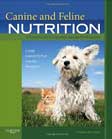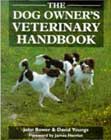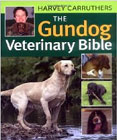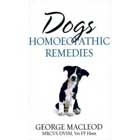Dogs: Health and nutrition
If you want to buy a book, clicking on the book
cover will take you directly to that book on the Amazon.co.uk web site.
See also:
 Dogs:
General Dogs:
General
 Dogs:
Books on single breeds Dogs:
Books on single breeds
 Dogs:
Origins, canine evolution and wolves Dogs:
Origins, canine evolution and wolves
 Dogs: Puppy and manners training Dogs: Puppy and manners training
 Dogs: Skills training: Agility and training games Dogs: Skills training: Agility and training games
 Dogs: Skills training:Sheepdog, gundog and scent work Dogs: Skills training:Sheepdog, gundog and scent work
 Dogs: Behaviour and training philosophies Dogs: Behaviour and training philosophies
 Dogs:
Breeding and kennel management Dogs:
Breeding and kennel management
 Dogs: Fiction
and biography relating to dogs Dogs: Fiction
and biography relating to dogs |
 |
|
|
|
|
|

Click on the cover above
to go to this book
at Amazon.co.uk
|

Raw & Natural Nutrition for Dogs: The Definitive Guide to Homemade Meals
Lew Olson North Atlantic Books,U.S. (22 Jun 2010)
ISBN-10: 9781556439032
ISBN-13: 978-1556439032
ASIN: 1556439032
This is a well researched book which covers both raw feeding and homecooked meals for dogs. There is a lot of information on canine nutrition, including the needs of younger and older dogs, and those with medical problems such as kidney disease, heart problems, and digestive system problems. There´s help with preparing meals, and advice on how to give dogs balanced diets. There are benefits to feeding dogs home-prepared food that you can see in the short term, like better skin, and healthier teeth and gums, and home prepared diets can also help dogs to live longer. Just improvising with leftovers and a few butchers´ scraps isn´t really enough. Owners need information on nutrition and food preparation to be able to prepare nutritionally sound diets that suit their particular dog. This is probably the best guide around if you are just buying one book on home-prepared food.
 Top
of page Top
of page
|

Click on the cover above
to go to this book
at Amazon.co.uk
|

Canine Cuisine: How to cook tasty meals and treats that your dog will enjoy
Elaine Everest How To Books Ltd (25 Jun 2010)
ISBN-10: 1845284089
ISBN-13: 978-1845284084
This is a very useful book if you want to cook meals for your dog. It is easy to understand, fun to read, and well researched. It´s practical, there is advice on using leftovers, which is sensible, since most owners don´t want them to go to waste. There are a lot of recipes, and they are quite easy, and don´t need complicated lists of ingredients. There are biscuit recipes, main meal and kibble replacement suggestions, and ideas for healthy treats and titbits. There´s also help on how much to feed dogs, and what to feed them if they have put on a bit too much weight. There´s also information on what owners should avoid allowing dogs to eat. This book is very good value for the ideas and information it gives you.
 Top
of page Top
of page
|

Click on the cover above
to go to this book
at Amazon.co.uk
|

Canine and Feline Nutrition: A Resource for Companion Animal Professionals
Linda P. Case MS, Leighann Daristotle DVM PhD, Michael G. Hayek PhD, Melody Foess Raasch DVM Mosby; 3rd edition (29 Jun 2010)
ISBN-10: 0323066194
ISBN-13: 978-0323066198
This is what it says, a resource for professionals. It gives more detail than the average pet owner needs, but is very useful if you have a kennel, or are a professional working with dogs. It is up to date, and covers diets for dogs with various medical conditions, as well as diets to keep dogs healthy. It´s a book you can use for reference if you are a vet or trainer, to be able to advise clients, and their questions with confidence, because the team which wrote the book has a great deal of accumulated specialist knowledge. The book is pricey, and expensive for the average dog owner, but is a good investment if you work with dogs.
 Top
of page Top
of page
|

Click on the cover above
to go to this book
at Amazon.co.uk
|

The Dog Owners' Veterinary Handbook
John S. M. Bower, David Youngs
The Crowood Press Ltd; 2nd edition (28 Mar 1994)
ISBN-10: 1852238267
ISBN-13: 978-1852238261
This is a very easy to understand book, geared to pet owners who have a sick dog. It deals with all aspects of canine health, from pups to older dogs. The great benefit of this book is that it is easy to read, though it´s not quite as thorough as ´The Dog Owner´s Home Veterinary Handbook´ by Debra M. Eldredge and others, which is also on this page. This book is more reassuring though, and less likely to make you imagine your dog has all sorts of ailments that he may not have. It´s especially helpful if used together with a vet, and can help you to communicate much better with your vet.
 Top
of page Top
of page
|

Click on the cover above
to go to this book
at Amazon.co.uk
|

Anatomy of the Dog: In Straightforward Terms
Kerstin Mielke Cadmos Equestrian; Reprint edition (7 July 2010)
ISBN-10: 3861279797
ISBN-13: 978-3861279792
This is a useful book for people who like drawing dogs, as well as for canine health professionals. It´s a very accessible guide, rather than a deeply technical work, and has nice, clear illustrations. Kerstin Mielke works as a physiotherapist for dogs, so is well able to explain how a dog´s body works, and different aspects of canine anatomy. The stress is on how dogs move, though this is a comprehensive guide, also covering inner organs, skin and coat, the nervous system and the senses.
 Top
of page Top
of page
|

Click on the cover above
to go to this book
at Amazon.co.uk
|

The Gundog Veterinary Bible [Illustrated] (Spiral-bound)
Harvey Carruthers
Quiller Publishing Ltd; Spi edition (29 Jun 2009)
ISBN-10: 1846890500
ISBN-13: 978-1846890505
The Gundog Veterinary Bible a very useful manual for anyone who likes an active life with their dog, not just gundog owners. There is help on what to do in emergencies, such as when a dog has eaten something poisonous, or broken a leg. There is also advice on preventing problems, which is well worth reading, so that you do not have to use the advice for emergencies. The author is the vet columnist of Shooting Times, Harvey Carruthers MRCVS.
The book is very accessible, clearly written, with good illustrations. It is a handy size to take on journeys, and is also spiral bound, so it stays open on a car seat, which means that you can follow instructions and check on the dog at the same time. Very highly recommended.
 Top
of page Top
of page
|

Click on the cover above
to go to this book
at Amazon.co.uk
|

Natural Nutrition for Dogs & Cats: The Ultimate Diet
Kymythy Schulze
Hay House
ISBN: 1561706361
This book is a very useful reference manual for people who want to give
their cats and dogs home-prepared food. There is a lot of practical help,
with information on nutrition, as well as menu plans, and a troubleshooting
guide for dealing with health problems. It's an especially useful book
for people whose pets have allergies, or have otherwise reacted to commercial
foods. This is especially true in Europe, since we usually get precious
little information on what goes into commercial pet food, compared to
people in the US, and that can be a problem for people whose pets have
food intolerances.
 Top
of page Top
of page
|

Click on the cover above
to go to this book
at Amazon.co.uk
|

Work Wonders: Feed Your Dog Raw Meaty Bones
Tom Lonsdale
Publisher: Rivetco Pty Ltd; 1 edition (Nov 2005)
ISBN-10: 0975717405
ISBN-13: 978-0975717400
A few decades ago, dogs were fed scraps. Gradually, canned food and biscuits, and then kibble crept into their diets, and we were told that this was healthier for them. A few years back I visited a friend in Spain, and watched her dog munching chicken's necks. His teeth were in excellent shape for an 11-year-old. A while later I shopped in a hardware store where a sales rep was complaining that pet owners just cared about whether dog poo was easy to pick up, not its nutritional content. So that was what the company focused on. The local stockmen carried scraps to their guard dogs every day. The kibble 'burned up the dogs' they said.
So yes, kibble may be better than giving dogs human junk food, but there are alternatives that dogs much prefer, and this book explores them. Dr Tom Lonsdale covers different aspects of raw food for dogs and cats in eight chapters, including sourcing, storage, and prepararation of raw food. He also deals with possible risks, as well as advantages. On the plus side, this book is clearly written, and a great help both for people starting out on raw food diets, as well as people with more experience. It is not an academic treatise, which means it's easy to read. Critics may argue that there should be more scientific backing for some of his claims, but this is an excellent introductory guide on raw feeding for dogs, and is enough for the needs of most pet owners.
 Top
of page Top
of page
|

Click on the cover above
to go to this book
at Amazon.co.uk
|

Food Pets Die For: Shocking Facts About Pet Food
Ann Martin
NewSage Press; 3rd edition (23 July 2008)
ISBN-10: 9780939165568
ISBN-13: 978-0939165568
ASIN: 0939165562
Owners who would rather not worry about what goes into pet food should
not read this book! Ann Martin could be described as an obsessive, though
it's easy to understand why, given her account of her dealings with the
pet food industry after she experienced problems with commercial dog food.
At the very least, this book points to the need for pet owners to ask
questions of pet food companies, such as what additives they use, and
why, and to tell them about problems we have when we use their products.
Owners often say they switch brands because one brand upsets their dog's
stomachs. It's worth telling the companies about this in case they think
we don't buy their food because it hasn't enough pretty colours! This
book also points to a need to campaign for better consumer information
on cans, so we can make informed decisions on our pets' behalf. This is
a consumer issue. Most of us haven't time to make tasty dog meals, so
we have to use what the pet food companies supply. Some owners might argue
that Ann Martin is not 'scientific' enough. But even if you discount seventy
five percent of what she says, it still leaves some awkward questions.
Those readers who assume that the British market is better regulated,
so British pets are always offered safe food, could maybe reflect on BSE
and the debate on the human food industry!
 Top
of page Top
of page
|

Click on the cover above
to go to this book
at Amazon.co.uk
|

The Dog: Its Behavior, Nutrition and Health
Linda Case
WileyBlackwell; 2nd Edition edition (18 Jul 2005)
ISBN-10: 0813812542
ISBN-13: 978-0813812540
Linda Case is a nutrition specialist, and an academic, as well as a trainer
and dog behaviourist. This is an excellent reference book, both for animal
care students and professionals and for ordinary dog owners. It is solid
and well-researched, while being accessible to non-specialists. Owners
with more than one dog, or who plan a lifetime of dog ownership, will
find this book well worth investing in, both for the material on dog behaviour,
and for the information on nutrition. There is also help with understanding
canine physiology and preventing and dealing with health problems. This
book is perhaps more suited to people aiming for a career with dogs, because
you do need some commitment to get through the more technical sections,
though the background understanding of canine physiology which she provides
is useful for ordinary pet owners in understanding their dogs' health
needs.
 Top
of page Top
of page
|

Click on the cover above
to go to this book
at Amazon.co.uk
|

Dog Owners Home Veterinary Handbook
Debra M. Eldredge DVM, Liisa D. Carlson DVM, Delbert G. Carlson DVM, James M. Giffin MD, Beth Adelman John Wiley & Sons; 4th edition (Aug 2007)
ISBN-10: 0470067853
ISBN-13: 978-0470067857
This is an excellent dog-owner's veterinary guide though it is geared to a US market. It's easy to use, and has clear explanations, rather than trying to blind you with science. It's no substitute for a vet, but can help you make better use of your vet's advice, and help with emergencies, while you wait for a vet. It provides as much information as the average dog owner is likely to need. No vet book designed for non-vets to use is perfect. Kennel owners or dog breeders may need a more comprehensive work, but this is probably the best vet book of those which are easily understood by non-specialists.
 Top
of page Top
of page
|

Click on the cover above
to go to this book
at Amazon.co.uk
|

Dog First Aid: A Field Guide: Emergency Care for the
Hunting, Working, and Outdoor Dog (Field Guide)
Randy Acker, Jim Fergus, Christopher Smith (Illustrator)
Wilderness Adventures Press
ISBN: 1885106041
This is an excellent short guide to first aid for your dog, which is
very useful for anyone taking a dog hunting, camping or on long walks
in the middle of nowhere. It is clearly written, with helpful illustrations,
so is easy to use in an emergency. It's well worth taking this book with
you if you go on holiday with your dog.
 Top
of page Top
of page
|

Click on the cover above
to go to this book
at Amazon.co.uk
|

Homeopathic Care for Cats and Dogs: Small Doses
for Small Animals
Don DVM Hamilton
North Atlantic Books
ISBN 155643295X
This is an easy to follow guide to homeopathic care from Don Hamilton,
who is a vet who specialises in homeopathic care. He explains homeopathy
and the processes of disease, as well as providing remedies for a number
of common afflictions, such as flea trouble, gum disease, digestive and
respiratory problems. He also provides help for people whose pets have
behavioural problems. There is enough in this book to interest those who
already have a knowledge of the subject, as well as people who know little
about homeopathic remedies for pets. Don Hamilton's book deals with homeopathic
care of cats as well as dogs, and this helps give a broader understanding
of homeopathy, though this book is a bit more expensive than George Macleod's
book.
 Top
of page Top
of page
|

Click on the cover above
to go to this book
at Amazon.co.uk
|

Dogs: Homeopathic Remedies
George MacLeod
Rider; New edition (Oct 2005)
ISBN-10: 9781844131969
ISBN-13: 978-1844131969
ASIN: 1844131963
A very popular, comprehensive guide to homeopathic remedies for dogs.
George Macleod is a vet who has built up a vast amount of expertise, treating
different animals with these remedies, often being successful when conventional
medicines did not work. It's a guide that is easy to read, and you don't
have to be a 'natural dogs care nut' to find it useful - homeopathic remedies
can be used alongside conventional remedies, in consultation with your
vet. As vets are starting to take homeopathic treatments more seriously,
you may find that your vet has read the book, or wants to borrow it from
you!
 Top
of page Top
of page
|

Click on the cover above
to go to this book
at Amazon.co.uk
|

Dr Pitcairn's Complete Guide to Natural Health for Dogs
and Cats
Richard H. Pitcairn
Rodale Books
ISBN: 0875962432
This is a very popular and accessible guide to holistic cat and dog care.
There's a lot of help with both diet and health care. Some of the recommendations
on nutrition are controversial, but there are many good ideas for improving
your pet's diet. All aspects of care are dealt with, including exercise,
grooming, and tackling emergiencies. Much of what Dr Pitcairn says about
commercial pet foods and vaccinations is not new, but the detail he gives
for alternative approaches is very helpful, especially for owners of pets
prone to allergies.
 Top
of page Top
of page
|

Click on the cover above
to go to this book
at Amazon.co.uk
|

The Holistic Guide for a Healthy Dog,
Wendy Volhard
Howell Books
ISBN: 1582451532
This is a revised edition of a thorough and fairly comprehensive guide
to holistic health care for dogs. It's more demanding than Richard Pitcairn's
book, which is perhaps easier for most people to start off with, unless
they have special veterinary knowledge. Topics covered include diet, vaccinations,
homeopathic remedies, allergies, and understanding lab tests. Canine diet
is a highly contentious area, and not everyone agrees with Volhard's recommendations,
but she does explain the rationale behind what she recommends, and it
is up to readers to decide. Any pet owner with an interest in holistic
medicine is likely to find this an invaluable resource.
 Top
of page Top
of page
|

Click on the cover above
to go to this book
at Amazon.co.uk
|

Control of Canine Genetic Diseases
George Padgett
Hungry Minds Inc
ISBN: 0876050046
A very useful book for anyone who wants to breed from their dog and cares
about producing healthy pups. It is geared to the US market, but the practical
advice given is helpful for UK breeders as well. Padgett provides a clear
explanation of how diseases can be inherited, and how to analyse pedigrees,
without overwhelming you in theory.
 Top
of page Top
of page
|

Click on the cover above
to go to this book
at Amazon.co.uk
|

The Genetics of the Dog
A. Ruvinksy, J. Sampson
Cabi Publishing
ISBN: 0851995209
This is a book for people with a particular interest in dog genetics,
either as breeders, or because they are more generally interested genetic
issues relating to dogs. It's quite technical and expensive and is very
thorough - not a book for most pet owners! There are nineteen articles
which examine different aspects of canine genetics, such as origins of
dogs, the impact of domestication, and genetic issues relating to disease
and behaviour. The book is as up to date as is possible in a fast changing
field, since it came out in 2001. It's a key text for students of canine
genetics.
 Top
of page Top
of page
|

Click on the cover above
to go to this book
at Amazon.co.uk
|

Veterinary advice on Hip Dysplasia in Dogs
Gary Clayton Jones BvetMed, DVR, DSAO, MRCVS
Ringpress Books
ISBN 1860542271
Hip dysplasia is sadly a common condition that most dog lovers have at
least heard of, if not lived with.
This book is aimed at pet owners who may be either living with a dog
who is already suffering from the symptoms of hip dysplasia or researching
breeds that are particularly prone to this condition.
Each stage of hip dysplasia is clearly explained, with clearly drawn
diagrams and x-rays. More complicated medical terms are spelt out for
the reader within the context of the sentences where they appear, and
you are guided through from the understanding of how a healthy hip should
work; how hip dysplasia affects the joints; possible causes and contributing
factors; diagnosis and treatments; and finally the author looks forward
to prevention and control of the disease in future generations.
Although all medical names and terms are well-explained as they appear,
I still felt that for a ‘medical book’ aimed at owners of pet
dogs, a glossary at the back of the book would have been useful. On a
few occasions when they reappeared, I had to stop and remember what the
some of the words meant, and I could have found them faster with a glossary.
Of course, if you suspect your dog might have this condition your first
port of call should be to your own veterinary surgeon for diagnosis and
advice specific to your own dog’s needs, but this book fills in all
the little gaps, answering questions about why your dog might need a particular
type of treatment, questions your own vet might not have time to answer.
It can also help you ask the right questions when you go back to your
vet, and it can help you understand what your vet needs. Quite often,
when we first hear a sad diagnosis we are too shocked to take in what
a doctor or vet is saying, so it can help to go back and listen to the
vet again, when we have had time to reflect and find out more from sources
such as this book.
As a reader with first hand experience of a dog who suffered with hip
dysplasia, I personally feel that this book is an invaluable resource
and would strongly recommend it – I only wish it had been available
when I was in the position of making difficult decisions for my dog.
 Top
of page Top
of page
See also:
 Dogs:
General Dogs:
General
 Dogs:
Books on single breeds Dogs:
Books on single breeds
 Dogs:
Origins, canine evolution and wolves Dogs:
Origins, canine evolution and wolves
 Dogs: Puppy and manners training Dogs: Puppy and manners training
 Agility and training games Agility and training games
 Sheepdog, gundog and scent work Sheepdog, gundog and scent work
 Dogs: Behaviour and training philosophies Dogs: Behaviour and training philosophies
 Dogs:
Breeding and kennel management Dogs:
Breeding and kennel management
 Dogs: Fiction
and biography relating to dogs Dogs: Fiction
and biography relating to dogs |
|
|
|